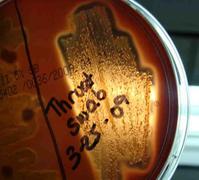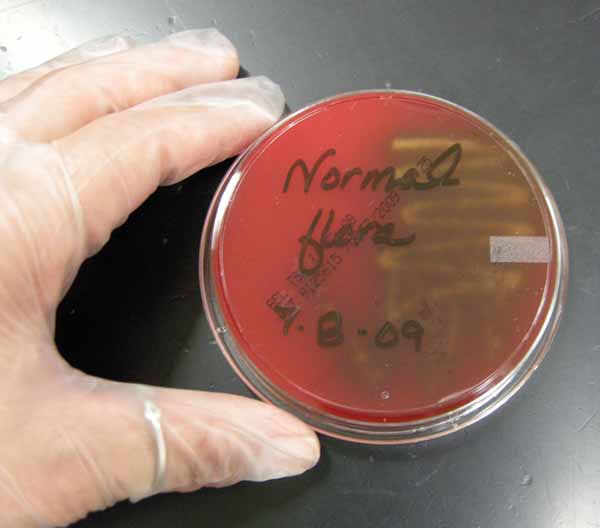 | ||||
Blood Agar (BAP) Bacterial Growth Medium - P2
SPO VIRTUAL CLASSROOMS
VIDEO: How to Interpret Blood Agar (BAP) Specialized Bacterial Growth Medium
Certain bacteria produce exotoxins called hemolysins, which act on the red blood cells to lyse, or break them down.
Hemolysis Patterns of Blood Agar
Beta hemolysis means that the bacteria's hemolytic exotoxins completely beak down the blood cells. The β-hemolysis pattern results in the media displaying clear halos around bacterial colonies.
Page last update: 3/2016
When Is Blood Agar (BAP) Used?
Blood agar is usually inoculated from a patient’s throat swab, because the medical laboratory is trying to detect the presence of Group A beta hemolytic Streptococci (a Gram-positive round shaped bacteria that causes beta-hemolysis on blood agar.) The major human pathogen in this group is Streptococcus pyogenes, the causative agent of strep throat. Normal throat flora will exhibit alpha or gamma hemolysis.
Want to see more photos? Blood Agar images
Sources and Helpful Link
- Schauer Cynthia (2007) Lab Manual to Microbiology for the Health Sciences, Kalamazoo Valley Community College.
- Bacterial Growth Media and Culture Lab Exercise Main Page from the Virtual Microbiology Classroom.
- Bauman, R. (2014) Microbiology with Diseases by Taxonomy, Pearson Benjamin Cummings.
PAGE 2 < Back to Page 1
End of Article < Back to Page 1
Blood agar (BAP) is a differential growth medium which microbiologists use to distinguish clinically significant bacteria from throat and sputum cultures. BAP contains 5% sheep blood.
Blood Agar Is a Differential Medium
A growth medium is considered differential if, when specific microbes are present, the medium or bacterial colonies themselves exhibit a color change that provides information about their identity.
Alpha hemolysis (α-hemolysis) means that the bacteria generate chemicals that only partially break down the blood cells. This results in the media showing a brownish discoloration (like a bruise) around the colony, indicating incomplete hemolysis.
Alpha Hemolysis
Throat swab that resulted in Beta-hemolysis, indicating the presence of pathogenic bacteria Steptococcus pyogenes, the cause of
strep throat.
Gamma hemolysis is essentially no hemolysis at all. The bacteria have no effect on the red blood cells, and there is no change to the color of the medium.
SCIENCE PHOTOS
SCIENCE VIDEOS
Virtual Microbiology
Classroom
You have free access to a large collection of materials used in a college-level introductory microbiology course. The Virtual Microbiology Classroom provides a wide range of free educational resources including PowerPoint Lectures, Study Guides, Review Questions and Practice Test Questions.





